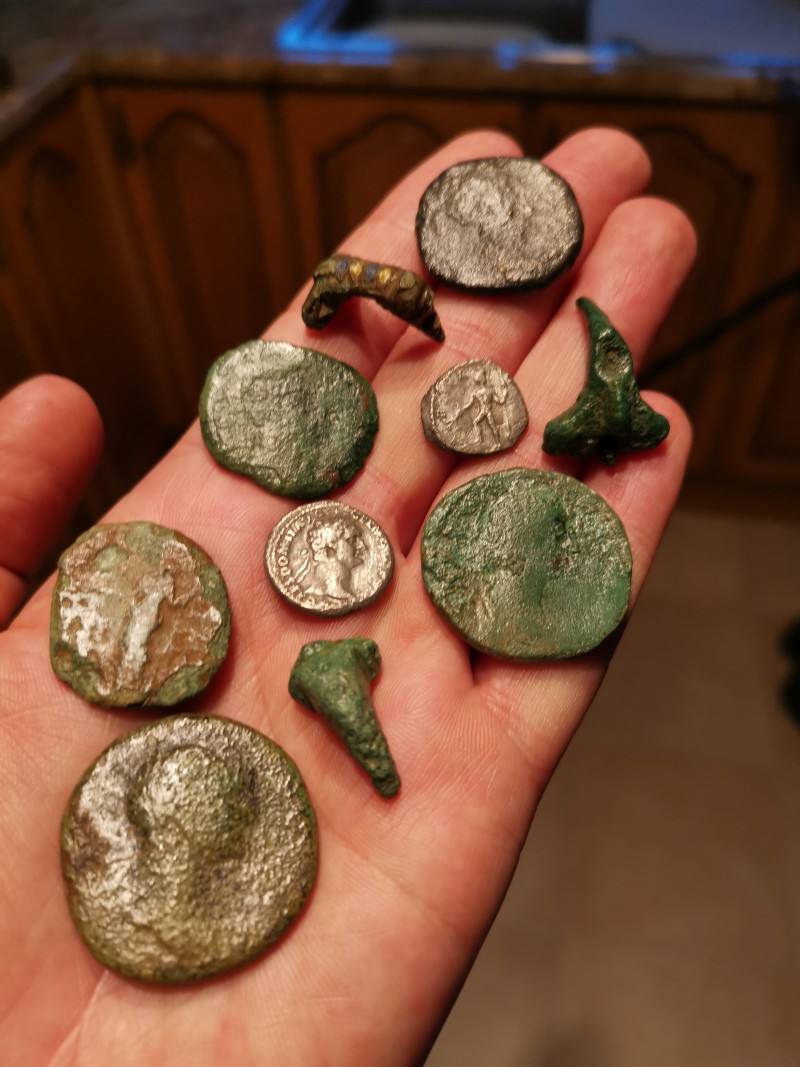STUMBLING upon Roman-era pottery in his garden set Andrew Allen on a journey of discovery. In the third instalment in a series of features unearthing the past, Ashley Ball digs deeper into almost 2,000 years of local history.
Luckily Andrew knew the value of what he was digging up. He is thankful that his own thriftiness resulted in him deciding to bury rubble rather than get a skip. That is when he quickly began to unearth Roman pottery which had not seen the light of day for 1,800 years.
A crowdfunding project, back in 2014, was quickly set up and a full excavation took place in his Toll Bar Road, Swinton, garden. The discoveries there were analysed by an expert at Leicester University and were deemed to be from between 200 and 300AD, six decades or so after the notorious rule of Hadrian.
“I was just digging a hole to put the rubble in because I was being a cheapskate,” smiled Andrew, 36. “But bits of Roman pottery began to come out. I had always had an interest in it so I recognised it. “Money was raised to do a full excavation over a week. It remains the only crowdfunded archaeological dig in South Yorkshire.
“There were 100-odd pieces there and some Iron Age pottery. It was domestic pottery and there was also a quern-stone.
“It was definitely a well-used site and there is a possibility that there was a structure.
“I think there must have been a decent-sized settlement nearby.
“One of the theories was that there were a lot of soldiers coming out of the army and that they were given land to provide for the fort at Templeborough (near Rotherham).
“I know there was a large coin hoard found just across the road in 1853 but nobody knows where they ended up.”
The hoard included 300-400 coins dated from the first to the third century and were discovered on nearby Rockingham Road by workers digging out a cellar. But Andrew’s find awakened Roman Swinton from its slumber once again.
Dr Lauren McIntyre, who had been involved in the garden dig, helped in the analysis of it.
She said: “Analysis by Roman pottery specialist Dave Griffiths, who has done work on pottery from sites including Pompeii, has proved that the pottery found in the ditch was made in South Yorkshire in the second to third centuries AD.
“It suggests that at this time people were living in the vicinity of the site. Some of the fabrics are very similar to examples that have been found at a well-known Roman cemetery site at Brougham in Cumbria and other sites in the north of England.”
After samian ware, traditional cooking ware and rusticted pottery came out of his garden, a casual interest was quickly made more serious for Andrew and he took up the investigation work himself as well as forming Swinton Archaeological Society. With locations kept secret to fend off potential criminal digging, Andrew can only reveal that he is still working on digging up the past in the Wath and Swinton area.
At the time of the Doomsday survey, Swinton was sparsely inhabited but there seems to be an agreement on its name with the old English calling it Swine Farm and Latin Villa Porcorum (house of pigs). The finds kept stacking up and it’s not just from the Roman era.
“We have found Roman items that pre-date the pottery,” added Andrew. “We have found coins from the first century with a Julius Caesar coin. There is quite a range so it shows that they were around for a few years.
“We have also found items from the Medieval period. There have been Viking stirrup mounts, seals and other day-to-day items. There has also been Medieval coinage, lead seals from the 12th century and items from the Tudor and Elizabethan period and an Edward I coin.”
It’s Andrew’s belief that when it comes to Swinton’s rich history, the surface has only just been scratched.
He added: “There was a community project after the dig where geophysics was done at nearby Swinton Fitzwilliam school and crop marks appeared last summer.
“It is a possibility that Swinton, which is shortened from swine town, could have originally been a Roman name. I think there is more under our feet.”
Andrew’s find is available to view at the museum at Clifton Park in Rotherham but it is currently closed due to the coronavirus outbreak.
There's subsequently been two more coin hoards found in the area, explains inspired digger, Andrew Allen.
He said: “The first of these consisted of two fourth century Roman coins. Both of these coins are of the main silver denomination of the late Roman period, the Siliqua.
“Siliquae were the last silver coins minted in the western Roman cities of the Roman Empire in the late fourth and early fifth centuries. They did continue to be circulated in Britain after the collapse of Roman rule in AD410.
“Interestingly both of the coins are contemporary forgeries and can be dated to be between AD375 to AD402. One of the coins shows evidence of a piercing.
“This tentatively points to a theory that the coin could have been repurposed to be worn as a pendant or some form of votive charm.
“It does however show that Roman occcupation in the area lasted well up until the end of the late fourth century.”
The quantities of Roman coins found all over England suggests that they left in a hurry and never returned to collect it.
Andrew added: “How the coins ended up in the ground is a mystery. Could they have been dropped by a passing Romano British citizen? Or were they burried as part or a larger, now disturbed, hoard in panic as the Roman empire collapsed. We will never know. Both of these coins were declared treasure and subsequently donated to Rotherham Museum.”
The second coin hoard consists of six Roman coins of the silver denomination, denarii - and are linked to arguably the most famous ever Roman.
“One is a Republican denarius of Julius Caesar dating from 49 BC, three are Flavian denarii dating from AD 74-96, and two are illegible denarii, probably of Hadrian and Nerva (AD 117-138 and AD 96-8 respectively).
“It is not unusual to find Republican denarii in hoards of the first or early second century. Indeed, they make up 25 per cent of the coins in Hadrianic (AD117-138) hoards and then go out of circulation rapidly.
“Both of the hoard show stark differences in date. The first being the late fourth century and the second the first century.
“This shows a period of well over 400 years of Roman occupation in the area.”
These coins are currently at the British Museum in London.



























